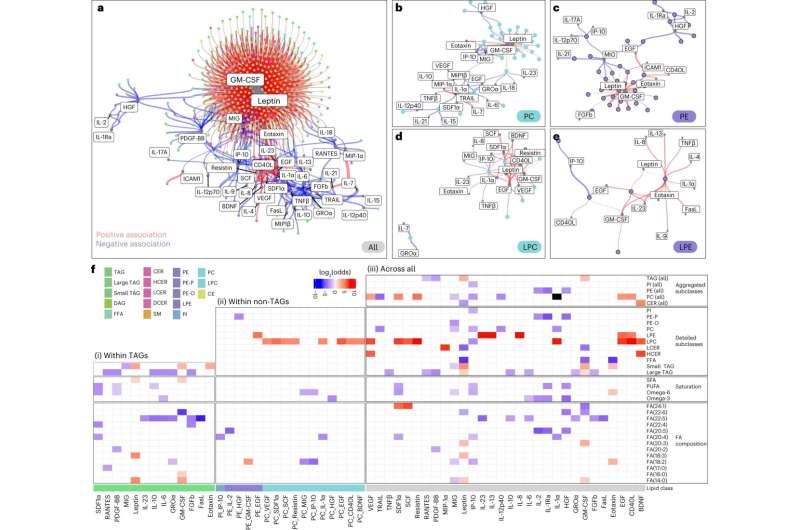This article has been reviewed according to Science X's editorial process and policies. Editors have highlighted the following attributes while ensuring the content's credibility:
fact-checked
peer-reviewed publication
trusted source
proofread
The human lipidome reveals new indicators of health, disease and aging

The sequencing of the human genome promised a revolution in medicine, but scientists soon realized that a genetic blueprint alone does not show the body in action. That required understanding the proteome—all the proteins, expressed by our genes, forming the cellular machinery that performs the bulk of the body's functions. Now, another set of molecules known as the lipidome—all the lipids in our bodies—is filling in more details of human physiology.
Lipids are a broad category of small, fatty or oily molecules, including triglycerides, cholesterol, hormones and some vitamins. In our bodies, they make up cell membranes, act as cellular messengers and store energy; they play key roles in responding to infection and regulating our metabolism.
Our genome is essentially stable. Our proteome, though influenced by our health and environment, is largely dependent on what's encoded by our genes. In contrast, our lipidome can be directly altered, in part, by what we eat and which microbes live inside our gut, making it more malleable and perhaps more responsive to interventions. But the number and variety of lipid molecules—there are at least thousands—has made them hard to study.
"Lipids are very understudied," said Michael Snyder, Ph.D., the Stanford W. Ascherman, MD, FACS Professor in Genetics. "They are involved in pretty much everything, but because they're so heterogenous, and there are so many of them, we probably don't know what most lipids really do."
A new study from Snyder's lab, published Nature Metabolism, is among the first to deeply dive into the human lipidome and track how it changes under healthy and diseased conditions, particularly in the development of type 2 diabetes.
Indicators of health
More than 100 participants, including many at risk for diabetes, were tracked for up to 9 years, providing blood samples every three months when healthy and every few days during illness.
Using mass spectrometry techniques, which separate compounds by their molecular mass and electric charge, researchers cataloged some 800 lipids and their associations with insulin resistance, viral infection, aging and more.
The researchers found that although everyone's lipidome has a distinctive signature that remains stable over time, certain types of lipids changed predictably with a person's health.
For example, more than half of the cataloged lipids were associated with insulin resistance—when the body's cells cannot use insulin to take up glucose from the blood—which can lead to type 2 diabetes. Though insulin resistance can be diagnosed by measuring blood glucose, understanding changes to the lipidome helps uncover the biological processes at work.
"Every molecule that is associated with a disease has a chance of telling us more about the mechanism and may be serving as a target for affecting the disease progression," said Daniel Hornburg, Ph.D., a former post-doctoral scholar in Snyder's lab and co-lead author of the study.
The researchers also identified more than 200 lipids that fluctuate over the course of a respiratory viral infection. Rising and falling levels of these lipids matched the body's higher energy metabolism and inflammation in early infection, and may indicate the trajectory of the disease. Those with insulin resistance showed some anomalies in these responses to infection as well as a weaker response to vaccinations.
Aging fast and slow
The wide age range of the participants—20 to 79 years old—and the length of the study allowed the researchers to see how the lipidome changes with aging. They found that most lipids, such as cholesterol, increase with aging, but a few, including omega-3 fatty acids, known for its health benefits, decrease. Moreover, these signs of aging in the lipidome do not occur at the same rate in everyone. Insulin resistance, for example, seems to accelerate them.
"It raises the interesting question of whether lipid profiles could predict whether an individual is biologically aging more quickly or more slowly," said Si Wu, Ph.D., co-lead author of the study and another former postdoc in Snyder's lab.
Another surprising insight, Wu said, was how consistently certain groups of lipids, such as ether-linked phosphatidylethanolamines, which are thought to be antioxidants and involved in cell signaling, were associated with better health. They may be candidates for new ways to monitor health or even taken as dietary supplements.
Next, Snyder's lab hopes to follow leads from this broad survey to look at correlations between specific lipids and lifestyle changes.
More information: Hornburg, D. et al, Dynamic lipidome alterations associated with human health, disease and ageing, Nature Metabolism (2023). DOI: 10.1038/s42255-023-00880-1 www.nature.com/articles/s42255-023-00880-1





















